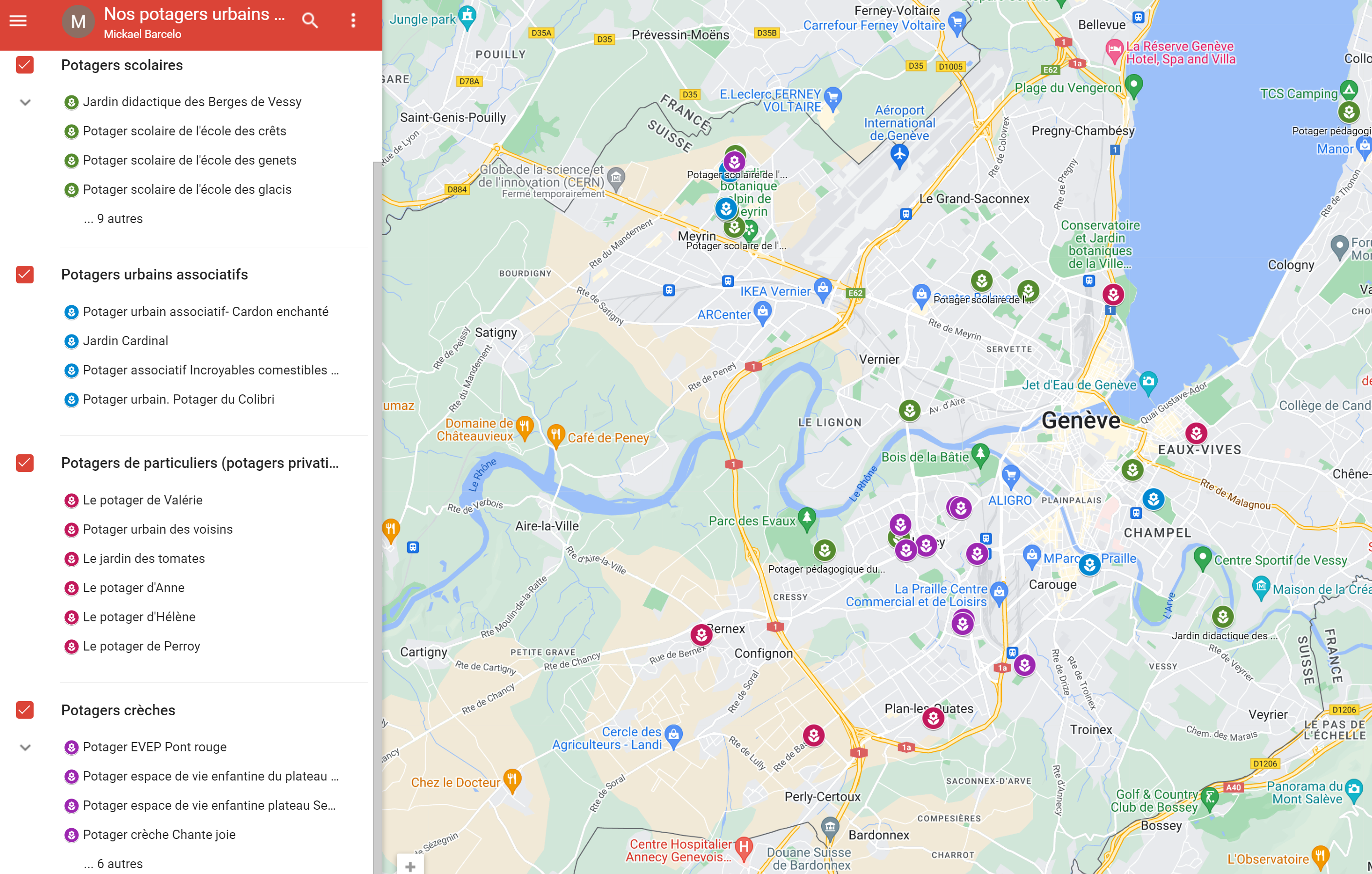Growing basil
Basil is easy to grow. However, it takes a bit of technique to produce a good crop. Where basil comes from, how to grow it and how to harvest it: we tell you all about this star vegetable!
Origin of basil
Theorigin of basil is uncertain… It is thought to have originated in South Asia or Central Africa.
One thing is certain: basil was already used in Egypt 4,000 years ago. In the 2nd century AD, basil was imported to Rome and quickly adopted throughout the Empire. It wasn’t until the 14th century that basil made its way across the English Channel and onto English tables. At the beginning of the 19th century, following the migratory flows to the West, basil set off to conquer the Americas! Today, basil is grown all over the world. But it remains symbolic of Asian and Mediterranean cuisine.
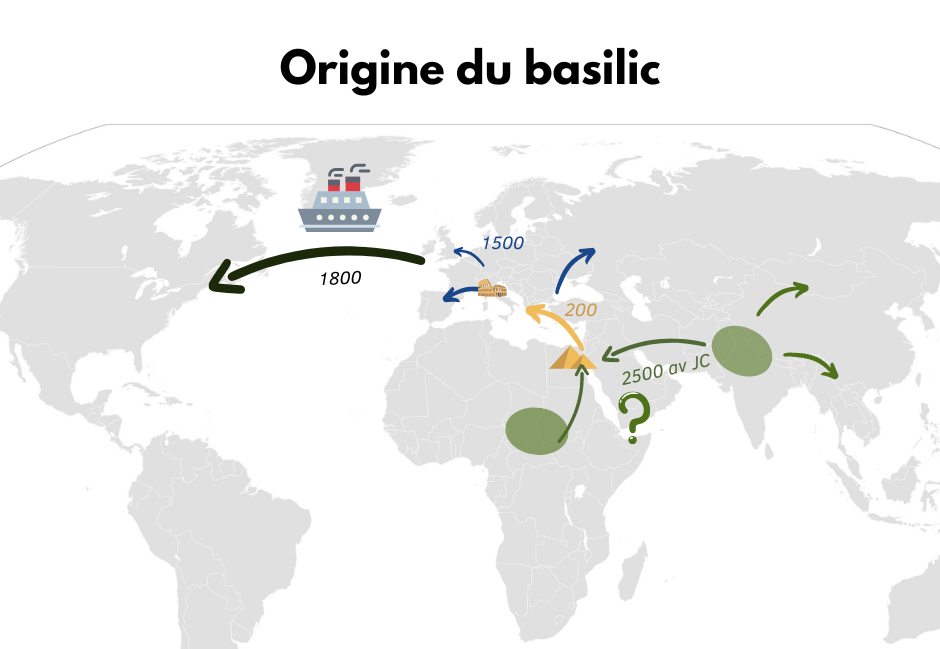
Variety selection
- Basil Genovese. This is the green basil we all know. Great in salads, on tomatoes and excellent in pesto.
- Large-leaf basil. Almost the same as Genovese, but with larger leaves.
- Tulsi basil (or holy basil). This variety has a sweet aroma and is mainly used in herbal teas. The leaves are hairy, which doesn’t make them very pleasant to eat raw. A very old and highly productive variety.
- Greek basil. Green variety with very small leaves. Very fine taste, can be eaten both raw and cooked. Very slow-growing variety, we recommend grafting (ideally onto a Tulsi or Crimean basil).
- Lemon basil. Small, light-green leaves. Ideal for fish or rice.
- Thai basil. Perfect for fish and Asian dishes. Also great in salads and on tomatoes.
- Basil leaf lettuce (or mammoth basil). A variety with gigantic leaves! A very distinctive aniseed taste. But its foliage alone is worth growing.
- Perpetual basil (or Kenyan basil): Perpetual…. Yes and no… Here in Switzerland, it’s not really perpetual. It’s clearly more resistant to the cold than the others. But it’s still a basil, it’s not a fir tree… so below 5°C it sulks; and dies when it freezes. Taste-wise, it’s similar to a wild species, but has a very strong taste (canfré) that makes it difficult to use in cooking.
- Crimean basil. One of the best-growing varieties here in Switzerland! Strong, vigorous, low yielding, it’s one of our favorites! The taste is similar to Genovese (but less pronounced).
- Purple basil. Basil with purple leaves and a taste very similar to Genovese. Can be used both raw and cooked.
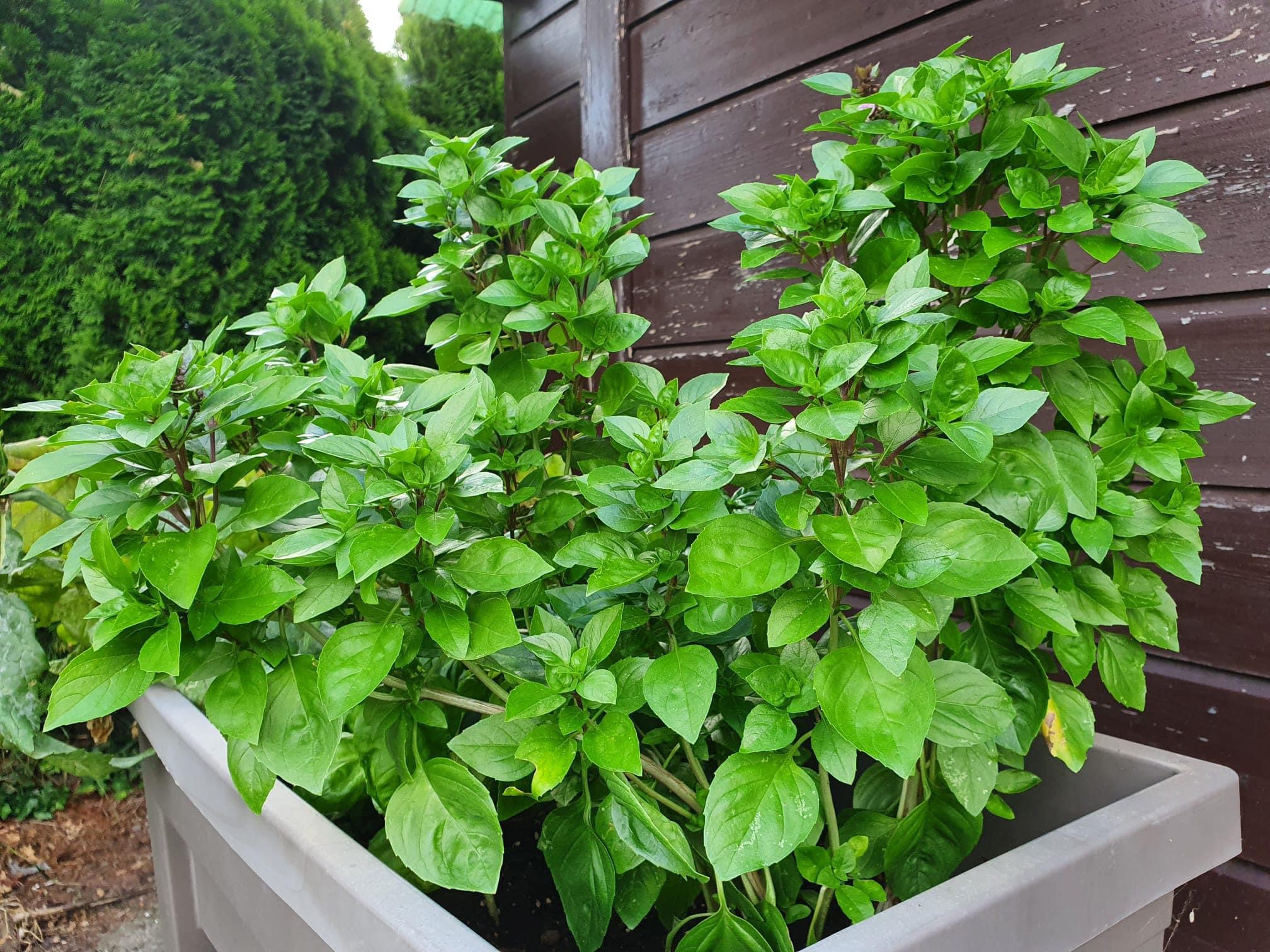
Crimean basil (candelabra shape)
Growing basil from seed
When to sow basil?
Basil takes a long time to grow. We recommend sowing basil at the same time as tomatoes. tomato seedlingsbetween early and mid-March. To germinate, basil needs a temperature of around 20°C.
How to sow basil?
The germination rate is very unpredictable, which is why it’s best not to sow seeds one by one in pots or trays. Instead, we recommend sowing basil in pots or terrines.
Sowing in stacks
In an individual pot or honeycomb tray, make a hole a few mm deep (no more, as the seed is very small). (Be careful not to sow them too deeply).
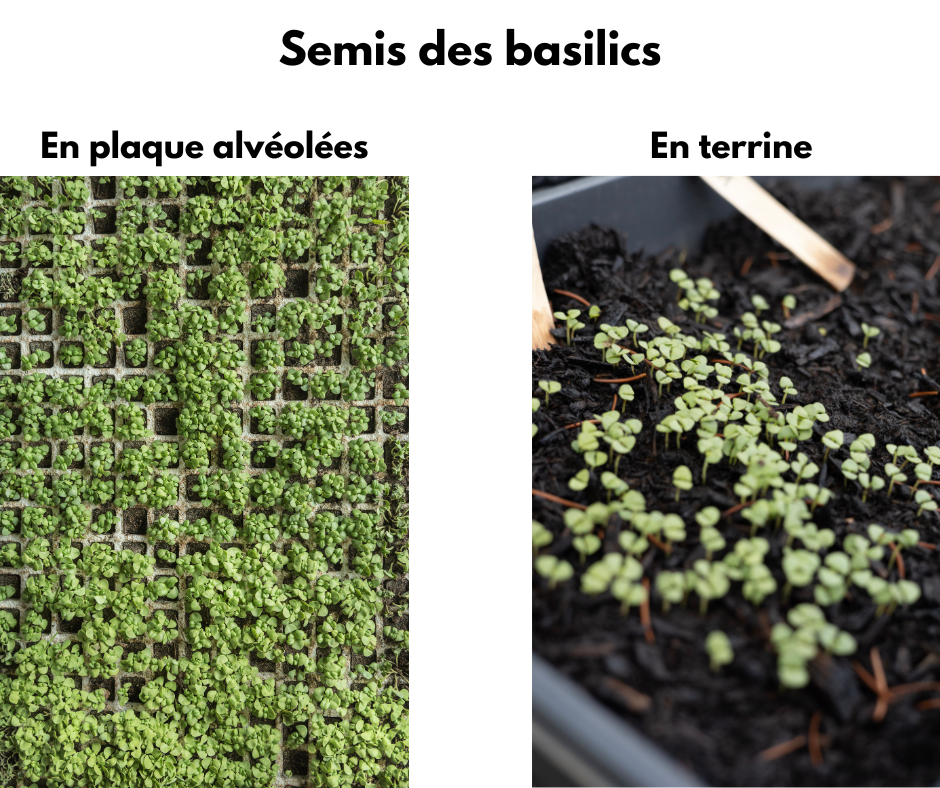
Sowing in a terrine
In a bowl, broadcast a few dozen seeds. Cover with 1 to 2 mm of sifted potting soil.
Replanting basil
When your basil plants have 2 to 4 pairs of « true leaves », it’s time to separate them and put them in individual pots.
Growing basil from commercial pots
Why do commercial basilisks die after purchase?
As you may have noticed, commercial pots of basil have an unfortunate tendency to die within a few weeks of purchase. This is normal, as these pots contain far too many plants in too small a space. Fed on fertilizer, they have no trouble surviving in the nursery. But when the pot leaves the nursery and arrives at your home, the supply of fertilizer is cut off, at which point the basil perishes.
To make them survive, simply separate them and place them in individual pots (or directly in the ground) as soon as you buy them.
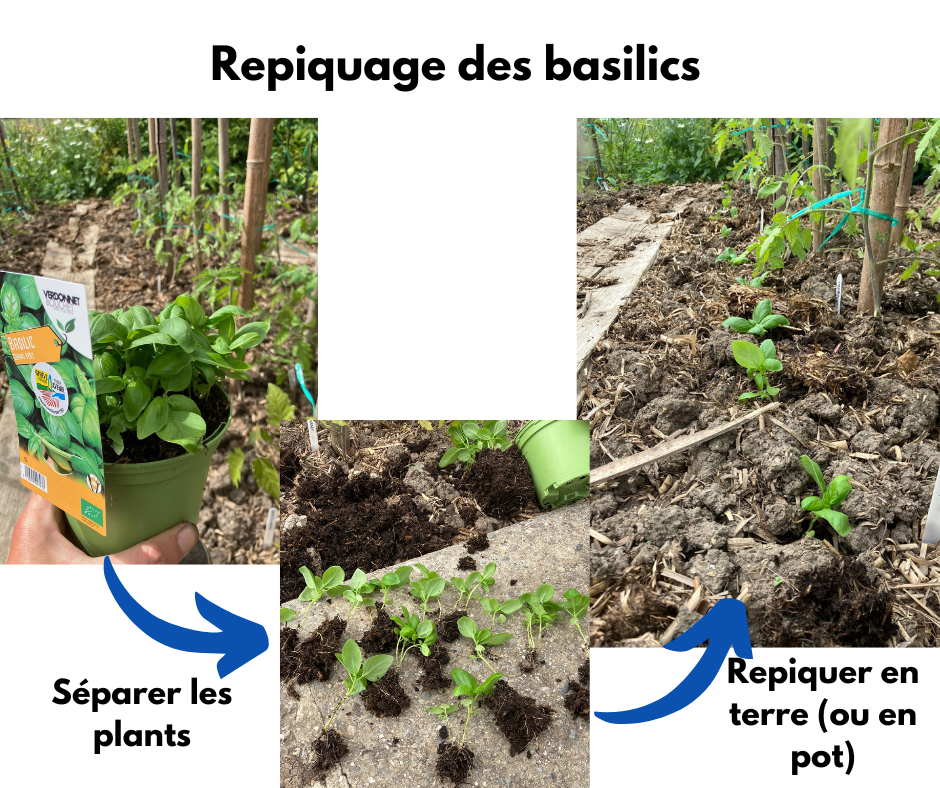
Plantation
Basil grows everywhere, but prefers rich, light, moist soil. Ten years ago, I’d have told you « it’s easy, basil, in full sun! »
Today, with the scorching summers, we recommend planting them in mid-shade (from mid-May), protecting them from the midday sun. Ideally, they should be placed in the shade of climbing plants (beans, tomatoes…). You can also plant them in pots and move the pot around during the season. From May to June, place the pot in full sun. July/August move the pot into the shade (under a tree or behind a building, so that it only catches the morning and/or evening sun ).
Basil likes moist soil, but does not like its feet in water (avoid leaving water in the dish if growing in a pot).
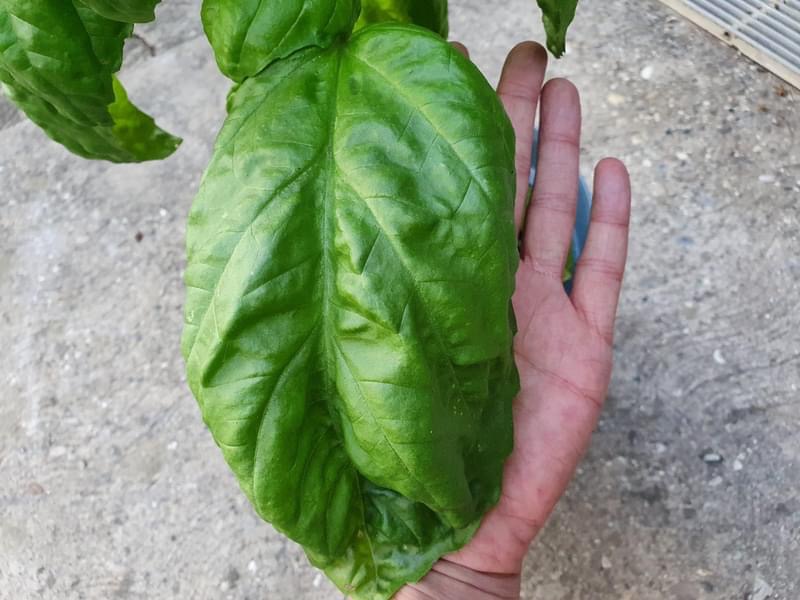
Basil lettuce leaf
Basil and permaculture. What plants should basil be grown with?
Basil grows well in the shade of tomatoes and peppers. It also grows well in the shade of string beans. Its very strong scent helps to protect the permaculture vegetable garden by disturbing certain insects that orient themselves by smell. (CAUTION, « it helps, but it’s not an immunity totem either…).
Cutting basil
Basil is one of the easiest plants to take cuttings from ! Just cut a few cm off the stem and place it in a glass of water to make a cutting. New roots will appear after 7 days. When the roots appear, you can place your cutting in the ground.

Growing basil in pots on your balcony
In our opinion, this is the best place to grow basil. In fact, on a balcony, you can move the pots around to vary the amount of light falling on your basil plants.
At home, basil is grown in a planter in full sun from May to the end of June. From July onwards, to keep the basil from baking in the sun, we move the pot away from direct light. This way, the foliage stays beautifully green, even in the hottest weather.
You can grow basil in window boxes or pots (minimum 5l pots per basil plant).
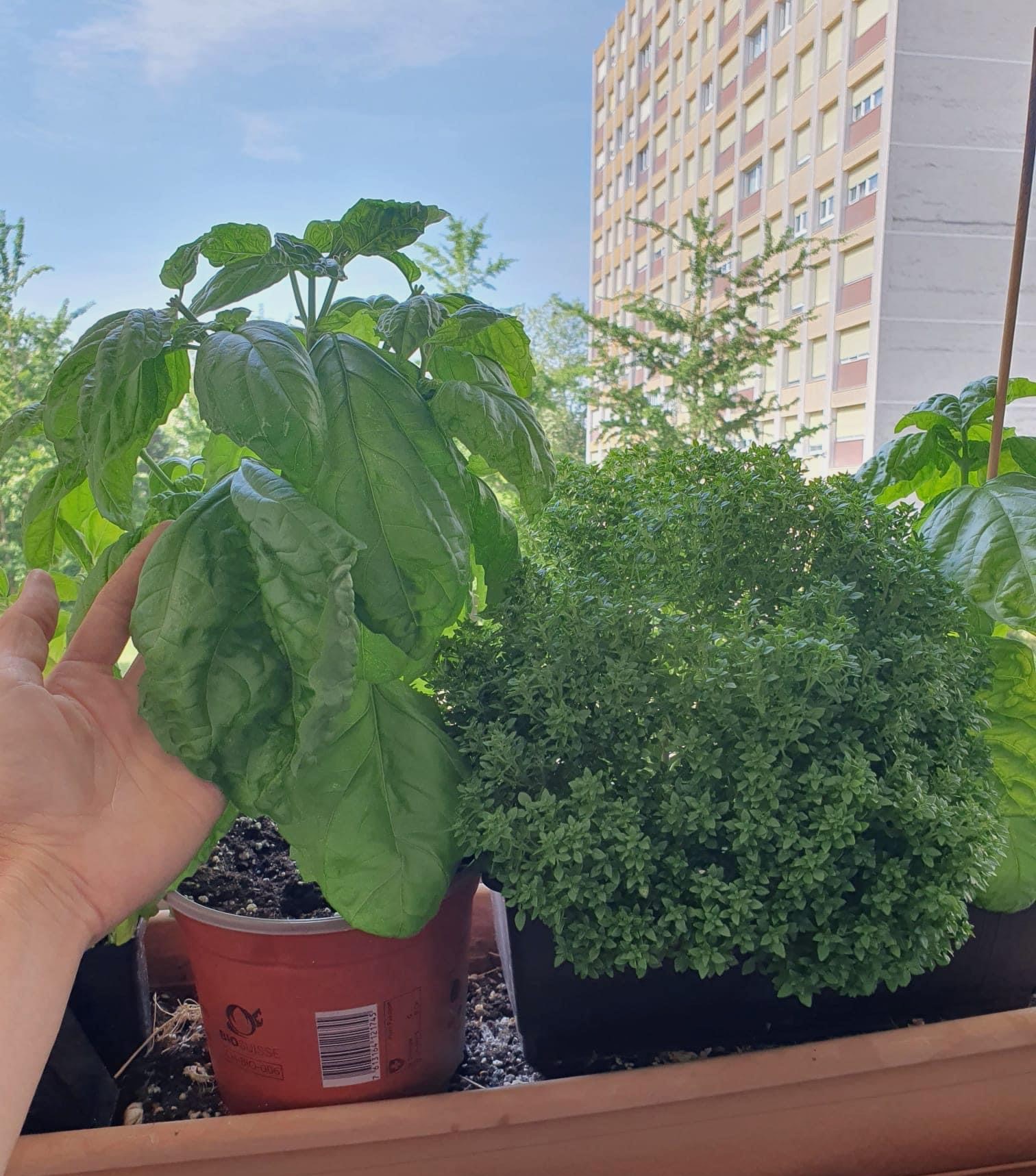
Lettuce leaf basil and Greek basil (grafted)
Growing, pruning and caring for basil
All basil plants grow with the same structure, a fir tree shape. Toincrease yields, we recommend pruning to force them into a candlestick shape.
The basil is topped after the 3rd knot. The basil will split and grow with 2 heads.
After the 3rd knot (of the 2 heads), cut the top again.
This way, your basil will have lots of branches and therefore lots of leaves to offer you.

Do basil flowers need pruning?
Yes and no… If you want to reproduce your plants and save seeds for next season, leave the flowers on and you’ll have seeds.
WARNING: basil plants are pollinated by bees, so the risk of hybridization is high.
What’s more, once seed production has started, the plant puts all its energy into the seeds and tends to die afterwards.
If you’re growing basil to harvest the leaves, cut off the flowers as soon as they appear, as this will force the plant to develop other branches and therefore other leaves. For harvesting, we recommend cutting branches rather than leaves. You’ll harvest more, and this will force the plant to make more branches.
Grafting basil
Basil is grafted in the same way as tomatoes. tomatoes are grafted. Slot grafting and Japanese grafting are the 2 most suitable methods for grafting basil.
For us, Greek basil is the only variety we recommend grafting. Greek basil takes a very long time to grow, so grafting it onto a Tulsi or Crimean basil will increase its vigor (dramatically), and thus increase harvests.

Grafted Greek basil
Preserving basil
Keep basil fresh:
To store fresh basil, simply cut off the stems and place in a glass of water. This way, you can store basil for up to 15 days.
Store basil in the freezer:
To preserve basil for a year, you can freeze it. To do this, cut off the stems and rinse. After wringing out the water, remove the stems and dry them on kitchen paper (for at least an hour). When completely dry, place in a zip-lock bag in the freezer. This way, no ice crystals will form, so you can use them simply by crumbling them into your dishes.
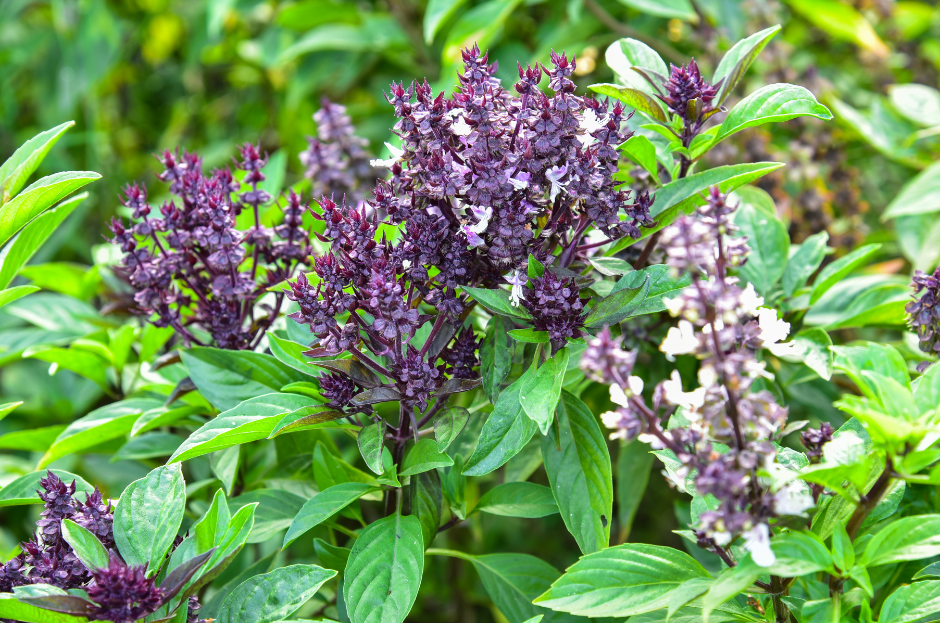
Growing basil seeds
To produce your own basil seeds, simply let the flowers and bees do their work. Once pollinated, wait for the flowers to dry out on their own. When the flower is completely dry and the seeds start to fall out on their own, it’s time to harvest them.
WARNING: Basils hybridize easily. You can’t reproduce several varieties in the same place at the same time.
Sorting basil seeds
Given the tiny size of basil seeds, we advise you not to sort them one by one… The easiest way is to crumble the flowers onto a tray, tilting the tray so that the seeds roll to one side, leaving the crumbs on the other.
Keeping basil alive for many years
Surprisingly, basil (in its native environment) is a perennial plant. It is an annual in gardens, as it cannot tolerate temperatures below 5 to 10°C (depending on the variety).
To keep a basil plant alive for several years, bring it in at the end of summer.
The best way to keep basil for 10 years, and the simplest, is never to take it outside and to grow it as a houseplant. Place it in a well-lit room, without draughts or wide variations in temperature. And change the soil in the pot every two years.
WARNING: overwintering basil is not easy! Cold, draughts, fungi, insects…. There are many factors that can kill your basil plants in winter.

Here a 10-year-old basil
Diseases, fungi and insects that attack basil :
It’s not just humans who love basil… Slugs, fungi, aphids and others love it too.
Here’s a (non-exhaustive) list of possible attacks and remedies:
- Botrytis: Also known as gray mold, this is caused by excessively high humidity. Remove infected parts. Prune a few branches to improve air circulation. Open the greenhouse if your plants are under cover.
- Basil blight Unfortunately, there’s not much to be done here… Winter is coming, the end of the season is near…
- Root rot: As mentioned above, basil doesn’t like its feet in water. Avoid leaving water in the dish if planted in a pot, to prevent root rot.
- Aphids: When the attack is too heavy, aphids can kill a basil plant. To get rid of them, you can spray a mixture of black soap and bicarbonate (for 1l of water, a capful of black soap and a teaspoon of bicarbonate). This mixture kills all insects with shells. Personally, we recommend integrated pest management using ladybug larvae, which target ONLY aphids.
- Whiteflies: Also known as whiteflies, here you can use black soap/bicarbonate. But here again, we prefer to use auxiliaries. The Swiss company Biogarten offers Encarsia formaparasitoid wasps that lay their eggs in whitefly larvae. This solves the problem at source.
- Potting soil flies: These little midges are generally found in poor-quality potting soil… So buy good potting soil; if midges are present, you’ll need to work on their larval phase. ( Yellow traps only act on the aerial phase. They must be used to identify and quantify the infestation; they do not solve the problem). Nematodes (still available from Biogarten) which can solve the problem once and for all.

